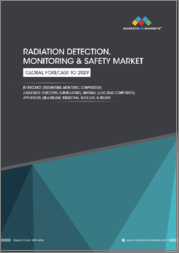
|
시장보고서
상품코드
1295360
세계의 신틸레이터 시장 예측(2023-2028년)Scintillator Market - Forecasts from 2023 to 2028 |
||||||
신틸레이터(Scintillator) 시장은 2021년 7억 59만 7,000달러에서 2028년 9억 7,407만 6,000달러에 달할 것으로 예상되고, CAGR 4.82%로 성장할 것으로 예측됩니다.
신틸레이터는 연구자가 다수의 방사선과 입자를 찾을 수 있게 합니다. 광전자 증배관과 포토다이오드는 후속 단계에서 입자를 이용하여 동시에 검출됩니다. 입자가 신틸레이터에 닿으면 신틸레이터는 입자의 에너지를 흡수하고 발광합니다. 신틸레이터는 일반적으로 크리스탈과 같은 투명한 재료로 구성되어 있지만, 중원소를 포함하는 것이 더 나은 성능을 발휘하기 쉬워집니다. 이는 신틸레이터가 물질의 감마선을 흡수할 수 있기 때문입니다. 이처럼 신틸레이터는 한 번에 많은 라벨링 실험을 할 수 있는 것이 보급의 원동력이 되고 있습니다.
또한 주요 제조업체의 기술개선에 대한 주력, 아시아 국가의 원자력발전소 증가, 광범위한 최종 용도에서 신틸레이터의 사용 확대가 신틸레이터 시장 성장으로 이어지고 있습니다.
또한 신틸레이터의 의료 스캔 및 기타 방사선 응용 분야에서 사용 증가, 심장 질환 및 신경 질환의 유병률 증가는 신틸레이터 시장 가치를 높일 것입니다. R&D 비용은 상승하고 신틸레이터 시장 확대에 길을 엽니다.
기술 진보의 확대가 시장 성장을 뒷받침하고 있습니다.
기술 진보 증가와 다양한 용도를 향한 참신한 기술이 시장을 촉진하고 있습니다. 다양한 조직이 이 기술을 조사했으며, 예를 들어 국토 안보부 국내 핵 검지국은 분광식 개인용 방사선 검출기의 신기술을 탐구하려고 하고 있습니다. 이 연구는 보다 우수한 검출 시스템을 개발할 뿐만 아니라, 핵물질이나 방사성 물질을 특정·인식하려고 하는 것입니다. 이 노력에 의해 만들어진 기술은 새로운 휴대용 가젯과 결합되어 정상적인 활동에 사용될 수 있습니다. DHS가 핵의 위협을 인식하고 봉쇄할 수 있는 능력을 향상시키기 위해 필수적인 핵·방사성 물질 검출 능력의 강화에 주력하고 있습니다.
패시브 고속 이동 중성자 검출 솔루션은 다양한 능동적 검출 방법에 걸쳐 차폐된 고유 핵물질의 검출을 증가시켜 특정 핵물질, 특히 무기급 플루토늄의 존재를 나타낼 수 있는 지표가 됩니다. 또한 신틸레이터의 고정밀도, 효능, 그리고 저레벨의 방사선을 검출하는 능력과 같은 매력적인 특성은 다양한 산업에서 수많은 진보를 끌고 있습니다.
또한 PET 스캐너에서 신틸레이션 재료를 사용하는 습관의 확대는 주요 국가의 의료기기 수익을 증가시키는 의료 이미징 기술의 발전에 크게 기여할 것으로 기대됩니다. 예를 들어 국제무역국의 2020년 보고서에 따르면 미국 의료기기 수익은 2019년 1,980억 달러에서 2020년에는 2,090억 달러로 증가했습니다.
의료 산업에서 응용은 신틸레이터 시장 수요를 촉진합니다.
신틸레이터는 평면 X선 이미징, X선 컴퓨터 단층촬영(X선 CT), SPECT, PET 스캔 등 다양한 의료 영상 진단 장치의 제조에 사용됩니다. 신틸레이터 및 신틸레이션 재료는 감마선과 X선의 정확한 위치, 방출 시간 및 변환 시간에 대한 관련 정보를 제공하고 정확한 이미지를 촬영하는 데 도움이 되기 때문에 이미징 장치에 사용됩니다. 따라서 종양이나 부상과 같은 만성 질환 증가로 진단 영상에 대한 수요가 증가함에 따라이 부문의 성장이 이어지고 있습니다. 최근 NHS 보고서에 따르면 영국은 2022년 4,400만 건의 이미지 검사를 기록했으며, 전년 3,490만 건에서 26% 증가했습니다. 가장 일반적인 것은 X선 검사로 2,180만 건(전년 대비 30% 증가), 이어 초음파 검사가 1,010만 건(동 23% 증가), 컴퓨터 단층 촬영이 670만 건(동 21% 증가), 자기 공명 영상 장치(MRI)가 380만 건(동 28% 증가)이었습니다.
신틸레이터는 평면 X선 이미징, X선 컴퓨터 단층촬영(X선 CT), SPECT, PET 스캔 등 다양한 의료용 이미징 장치의 제조에 사용됩니다. 신틸레이터 및 신틸레이션 재료는 감마선과 X선의 정확한 위치, 방출 시간 및 변환 시간에 대한 관련 정보를 제공하고 정확한 이미지를 촬영하는 데 도움이 되기 때문에 이미징 장치에 사용됩니다. 따라서 종양이나 부상과 같은 만성 질환 증가로 진단 영상에 대한 수요가 증가함에 따라이 부문의 성장이 이어지고 있습니다. 최근 NHS 보고서에 따르면 영국은 2022년 4,400만 건의 이미지 검사를 기록했으며, 전년 3,490만 건에서 26% 증가했습니다. 일반 X선 촬영이 가장 많아 2,180만 건(전년 대비 30% 증가), 이어서 진단용 초음파 검사가 1,010만 건(동 23% 증가), 컴퓨터 단층 촬영이 670만 건(동 21% 증가), 자기 공명 화상법(MRI, 380만건, 동 28% 증가)이 되고 있습니다.
만성 질환 증가와 유행성(세계적 유행)과 같은 상황에 따라 최신 진단 의료기기를 개발하기 위한 연구와 개발이 활발해지고 있으며, 헬스케어 분야에서 신틸레이터의 성장을 촉진하고 있습니다. 예를 들어, 2023년 5월, 플로리다 주립 대학의 과학자 그룹은 CT 스캔, 엑스레이 장비 및 기타 방사선 검출 및 이미징 기술의 화질을 향상시킬 수 있는 차세대 유기-무기 하이브리드 재료를 개발합니다. 했습니다. 화학·생화학과의 Biwu Ma 교수 등은 이 새로운 재료를 개발했습니다. X선 및 기타 고에너지 방사선에 노출되면 이러한 물질이 발광합니다.
목차
제1장 서론
- 시장 개요
- 시장 정의
- 조사 범위
- 시장 세분화
- 통화
- 전제 조건
- 기준연도 및 예측연도의 타임라인
제2장 조사 방법
- 조사 데이터
- 전제 조건
제3장 주요 요약
- 조사 하이라이트
제4장 시장 역학
- 시장 성장 촉진 요인
- 시장 성장 억제 요인
- Porter's Five Forces 분석
- 산업 밸류체인 분석
제5장 신틸레이터 시장 : 재질별 분석
- 소개
- 유기
- 무기
제6장 신틸레이터 시장 : 제품별 분석
- 소개
- 포켓 사이즈 장치
- 핸드헬드식 장치
- 고정형·거치형 시스템
제7장 신틸레이터 시장 : 최종 용도 산업별 분석
- 소개
- 의료
- 에너지 및 전력
- 제조업
- 방어
- 기타
제8장 신틸레이터 시장 : 지역별 분석
- 소개
- 북미
- 미국
- 캐나다
- 멕시코
- 남미
- 브라질
- 기타
- 유럽
- 영국
- 독일
- 프랑스
- 기타
- 중동 및 아프리카
- 사우디아라비아
- 이스라엘
- 기타
- 아시아 태평양
- 일본
- 중국
- 한국
- 인도
- 인도네시아
- 대만
- 기타
제9장 경쟁 환경 및 분석
- 주요 기업과 전략 분석
- 신흥기업과 시장 수익성
- 합병, 인수, 합의 및 협업
- 벤더 경쟁력 매트릭스
제10장 기업 개요
- Applied Scintillation Technologies Ltd.
- ARgus Imaging Bv Inc.
- Hamamatsu Photonics KK
- Radiation Monitoring Devices Inc
- Hitachi Metal Ltd.
- Mirion Technologies
- Siemens
- Zecotek Photonics Inc
- Ludlum Measurements
- Amcrys
- Saint Gobain
- Zecotek Photonics Inc.
The scintillator market is predicted to grow at a CAGR of 4.82% from US$700.597 million in 2021 to US$974.076 million by 2028.
Scintillators enable researchers to find numerous radiation and particles. The photomultipliers and photodiodes are simultaneously detected using the particles in a later step. When a particle strikes a scintillator, the scintillator emits luminesce by absorbing the energy of the particle. Scintillators, which typically consist of water-clear crystalline materials, are more likely to perform better if they contain heavy elements. This is since it enables the scintillators to absorb gamma radiation from the substance. The scintillators' capacity to conduct many labeling experiments at once is what is driving their wider use.
Further, expanding focus on technological improvements by the major producers, rising the number of nuclear power plants in Asian countries, and the expanding use of scintillators for a broad range of end-use applications are leading to the market growth of scintillators.
Moreover, the increasing use of scintillators in medical scanning and other radiological applications in medicine, as well as the rising prevalence of heart and neurological illnesses, will boost the scintillator market value. The cost of conducting research and development will rise, which will pave the way for the market for scintillators to expand.
Increasing technological advancements to boost market growth.
Growing technical advancement and novel technologies for a variety of uses is driving the market. Various organizations are researching this technology such as The Domestic Nuclear Detection Office of the Department of Homeland Security, which is trying to explore new technologies for Spectroscopic Personal Radiation Detectors. The study attempts to locate and recognize nuclear or radioactive sources as well as develop better detection systems. The technologies created through this effort could be combined with brand-new handheld gadgets and used in regular activities. It is putting a lot of effort into enhancing nuclear and radiological detection capabilities, which is essential to improving the DHS's capacity to recognize and contain nuclear threats.
The passive fast-moving neutron detection solution, which in turn increases the detection of shielded unique nuclear material across various active detection methods, is a possible indicator of the presence of certain nuclear materials, notably weapons-grade plutonium. Further, the enticing characteristics of scintillators, such as high precision, effectiveness, and the capacity to detect even lower radiation levels, are drawing numerous advancements in a variety of industries.
Additionally, the expanding practice of using scintillating materials in PET scanners is expected to significantly contribute to the development of medical imaging techniques which has increased the revenue for medical devices in major countries. For instance, as per the 2020 report of International Trade Administration, the revenue of medical devices in America increased from US$198 billion in 2019 to US$209 billion in 2020.
Application in the medical industry to boost the demand for the scintillators market.
Scintillators are used in the production of a wide variety of medical imaging devices such as planar x-ray imaging, x-ray computed tomography (x-ray CT), SPECT and PET scan. Scintillators and scintillating materials are used in imaging devices as they provide relevant information regarding the exact position, emission time and time of conversion of each gamma and X ray which help in taking precise images. Therefore, growing demand for diagnostic images because of rising prevalence of chronic disease such as tumors or injuries is driving the growth of this segment. According to a recent NHS report, in England, 44.0 million imaging tests were recorded in 2022, up from 34.9 million the previous year, representing a 26 per cent rise. Plain radiography or X-ray was the most common, accounting for 21.8 million treatments, an increase of 30 per cent from previous year followed by Diagnostic Ultrasonography with 10.1 million scans, an increase of 23 per cent), Computerized Axial Tomography recorded 6.7 million scans, representing an increase of 21 per cent, and Magnetic Resonance Imaging (MRI, 3.8 million, an increase of 28%).
Scintillators are used in the production of a wide variety of medical imaging devices such as planar x-ray imaging, x-ray computed tomography (x-ray CT), SPECT and PET scan. Scintillators and scintillating materials are used in imaging devices as they provide relevant information regarding the exact position, emission time and time of conversion of each gamma and X ray which help in taking precise images. Therefore, growing demand for diagnostic images because of rising prevalence of chronic disease such as tumors or injuries is driving the growth of this segment. According to a recent NHS report, in England, 44.0 million imaging tests were recorded in 2022, up from 34.9 million the previous year, representing a 26 per cent rise. Plain radiography or X-ray was the most common, accounting for 21.8 million treatments, an increase of 30 per cent from previous year followed by Diagnostic Ultrasonography with 10.1 million scans, an increase of 23 per cent), Computerized Axial Tomography recorded 6.7 million scans, representing an increase of 21 per cent, and Magnetic Resonance Imaging (MRI, 3.8 million, an increase of 28%).
Rising prevalence of chronic disease and pandemic like situations have led to increased research and trails to develop latest diagnostic medical devices, driving the growth of scintillators in the healthcare sector. For instance, in May 2023, a group of Florida State University scientists has developed a new generation of organic-inorganic hybrid materials that potentially improve picture quality in CT scans, X-Ray machines, and other radiation detection and imaging technologies. Professor Biwu Ma of the Department of Chemistry and Biochemistry and his colleagues developed these novel materials, which may be used as scintillators. When exposed to X-Rays and other high-energy radiations, these materials emit light.
Key Developments
- In August 2020, researchers from Florida State University created eco-friendly X-ray Scintillators with High Efficiency that are less expensive and environmentally hazardous than current technology.
- in November 2022, Canon Medical Systems Corporation (Canon Medical), a subsidiary of Canon Inc., has created the first photon-counting CT system using scintillators in the United States that incorporates Redlen's sophisticated technology. This system was deployed at Japan's National Cancer Centre Exploratory Oncology Research & Clinical Trial Centre, where it is now employed for research into the clinical uses of PCCT.
Segmentation:
By Material Type
- Organic
- Inorganic
By Product
- Pocket-Size Instruments
- Hand-Held Instruments
- Fixed or Installed Systems
By End-User Industry
- Healthcare
- Energy and Power
- Manufacturing
- Defense
- Others
By Geography
- North America
- USA
- Canada
- Others
- South America
- Brazil
- Others
- Europe
- UK
- Germany
- France
- Others
- Middle East and Africa
- Saudi Arabia
- Israel
- Others
- Asia Pacific
- China
- Japan
- South Korea
- India
- Indonesia
- Taiwan
- Others
TABLE OF CONTENTS
1. INTRODUCTION
- 1.1. Market Overview
- 1.2. Market Definition
- 1.3. Scope of the Study
- 1.4. Market Segmentation
- 1.5. Currency
- 1.6. Assumptions
- 1.7. Base, and Forecast Years Timeline
2. RESEARCH METHODOLOGY
- 2.1. Research Data
- 2.2. Assumptions
3. EXECUTIVE SUMMARY
- 3.1. Research Highlights
4. MARKET DYNAMICS
- 4.1. Market Drivers
- 4.2. Market Restraints
- 4.3. Porter's Five Force Analysis
- 4.3.1. Bargaining Power of Suppliers
- 4.3.2. Bargaining Power of Buyers
- 4.3.3. Threat of New Entrants
- 4.3.4. Threat of Substitutes
- 4.3.5. Competitive Rivalry in the Industry
- 4.4. Industry Value Chain Analysis
5. SCINTILLATOR MARKET ANALYSIS BY MATERIAL TYPE
- 5.1. Introduction
- 5.2. Organic
- 5.3. Inorganic
6. SCINTILLATOR MARKET ANALYSIS BY PRODUCT
- 6.1. Introduction
- 6.2. Pocket-Size Instruments
- 6.3. Hand-Held Instruments
- 6.4. Fixed or Installed Systems
7. SCINTILLATOR MARKET ANALYSIS BY END-USER INDUSTRY
- 7.1. Introduction
- 7.2. Healthcare
- 7.3. Energy and Power
- 7.4. Manufacturing
- 7.5. Defense
- 7.6. Others
8. SCINTILLATOR MARKET ANALYSIS BY GEOGRAPHY
- 8.1. Introduction
- 8.2. North America
- 8.2.1. United States
- 8.2.2. Canada
- 8.2.3. Mexico
- 8.3. South America
- 8.3.1. Brazil
- 8.3.2. Others
- 8.4. Europe
- 8.4.1. UK
- 8.4.2. Germany
- 8.4.3. France
- 8.4.4. Others
- 8.5. Middle East and Africa
- 8.5.1. Saudi Arabia
- 8.5.2. Israel
- 8.5.3. Others
- 8.6. Asia Pacific
- 8.6.1. Japan
- 8.6.2. China
- 8.6.3. South Korea
- 8.6.4. India
- 8.6.5. Indonesia
- 8.6.6. Taiwan
- 8.6.7. Others
9. COMPETITIVE ENVIRONMENT AND ANALYSIS
- 9.1. Major Players and Strategy Analysis
- 9.2. Emerging Players and Market Lucrativeness
- 9.3. Mergers, Acquisitions, Agreements, and Collaborations
- 9.4. Vendor Competitiveness Matrix
10. COMPANY PROFILES
- 10.1. Applied Scintillation Technologies Ltd.
- 10.2. Argus Imaging Bv Inc.
- 10.3. Hamamatsu Photonics K.K.
- 10.4. Radiation Monitoring Devices Inc
- 10.5. Hitachi Metal Ltd.
- 10.6. Mirion Technologies
- 10.7. Siemens
- 10.8. Zecotek Photonics Inc
- 10.9. Ludlum Measurements
- 10.10. Amcrys
- 10.11. Saint Gobain
- 10.12. Zecotek Photonics Inc.



















